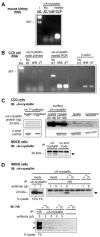Small heat shock protein alphaA-crystallin regulates epithelial sodium channel expression
- PMID: 17664274
- PMCID: PMC2361386
- DOI: 10.1074/jbc.M703409200
Small heat shock protein alphaA-crystallin regulates epithelial sodium channel expression
Abstract
Integral membrane proteins are synthesized on the cytoplasmic face of the endoplasmic reticulum (ER). After being translocated or inserted into the ER, they fold and undergo post-translational modifications. Within the ER, proteins are also subjected to quality control checkpoints, during which misfolded proteins may be degraded by proteasomes via a process known as ER-associated degradation. Molecular chaperones, including the small heat shock protein alphaA-crystallin, have recently been shown to play a role in this process. We have now found that alphaA-crystallin is expressed in cultured mouse collecting duct cells, where apical Na(+) transport is mediated by epithelial Na(+) channels (ENaC). ENaC-mediated Na(+) currents in Xenopus oocytes were reduced by co-expression of alphaA-crystallin. This reduction in ENaC activity reflected a decrease in the number of channels expressed at the cell surface. Furthermore, we observed that the rate of ENaC delivery to the cell surface of Xenopus oocytes was significantly reduced by co-expression of alphaA-crystallin, whereas the rate of channel retrieval remained unchanged. We also observed that alphaA-crystallin and ENaC co-immunoprecipitate. These data are consistent with the hypothesis that small heat shock proteins recognize ENaC subunits at ER quality control checkpoints and can target ENaC subunits for ER-associated degradation.
Figures





Similar articles
-
The small heat shock protein alphaA-crystallin is expressed in pancreas and acts as a negative regulator of carcinogenesis.Biochim Biophys Acta. 2010 Jul-Aug;1802(7-8):621-31. doi: 10.1016/j.bbadis.2010.04.004. Epub 2010 Apr 29. Biochim Biophys Acta. 2010. PMID: 20434541
-
The KDEL receptor has a role in the biogenesis and trafficking of the epithelial sodium channel (ENaC).J Biol Chem. 2019 Nov 29;294(48):18324-18336. doi: 10.1074/jbc.RA119.008331. Epub 2019 Oct 25. J Biol Chem. 2019. PMID: 31653700 Free PMC article.
-
The Lhs1/GRP170 chaperones facilitate the endoplasmic reticulum-associated degradation of the epithelial sodium channel.J Biol Chem. 2013 Jun 21;288(25):18366-80. doi: 10.1074/jbc.M113.469882. Epub 2013 May 3. J Biol Chem. 2013. PMID: 23645669 Free PMC article.
-
AlphaA-crystallin interacting regions in the small heat shock protein, alphaB-crystallin.Biochemistry. 2004 Dec 21;43(50):15785-95. doi: 10.1021/bi048151s. Biochemistry. 2004. PMID: 15595834
-
αA-crystallin and αB-crystallin reside in separate subcellular compartments in the developing ocular lens.J Biol Chem. 2012 Dec 7;287(50):42407-16. doi: 10.1074/jbc.M112.414854. Epub 2012 Oct 15. J Biol Chem. 2012. PMID: 23071119 Free PMC article.
Cited by
-
Neuroprotective effect of small heat shock protein, Hsp27, after acute and chronic alcohol administration.Cell Stress Chaperones. 2010 Nov;15(6):807-17. doi: 10.1007/s12192-010-0188-8. Epub 2010 May 12. Cell Stress Chaperones. 2010. PMID: 20461564 Free PMC article.
-
Molecular adaptation to calsequestrin 2 (CASQ2) point mutations leading to catecholaminergic polymorphic ventricular tachycardia (CPVT): comparative analysis of R33Q and D307H mutants.J Muscle Res Cell Motil. 2020 Sep;41(2-3):251-258. doi: 10.1007/s10974-020-09587-2. Epub 2020 Sep 9. J Muscle Res Cell Motil. 2020. PMID: 32902830 Free PMC article.
-
The thiazide-sensitive NaCl cotransporter is targeted for chaperone-dependent endoplasmic reticulum-associated degradation.J Biol Chem. 2011 Dec 23;286(51):43611-43621. doi: 10.1074/jbc.M111.288928. Epub 2011 Oct 25. J Biol Chem. 2011. PMID: 22027832 Free PMC article.
-
Paraoxonase 2 is an ER chaperone that regulates the epithelial Na+ channel.Am J Physiol Cell Physiol. 2022 Jan 1;322(1):C111-C121. doi: 10.1152/ajpcell.00335.2021. Epub 2021 Dec 1. Am J Physiol Cell Physiol. 2022. PMID: 34852210 Free PMC article.
-
The activities and function of molecular chaperones in the endoplasmic reticulum.Semin Cell Dev Biol. 2007 Dec;18(6):751-61. doi: 10.1016/j.semcdb.2007.09.001. Epub 2007 Sep 8. Semin Cell Dev Biol. 2007. PMID: 17964199 Free PMC article. Review.
References
-
- Garty H, Palmer LG. Physiol Rev. 1997;77:359–396. - PubMed
-
- Rossier BC, Pradervand S, Schild L, Hummler E. Annu Rev Physiol. 2002;64:877–897. - PubMed
-
- Mall M, Grubb BR, Harkema JR, O'Neal WK, Boucher RC. Nat Med. 2004;10:487–493. - PubMed
-
- Kosari F, Sheng S, Li J, Mak DO, Foskett JK, Kleyman TR. J Biol Chem. 1998;273:13469–13474. - PubMed
Publication types
MeSH terms
Substances
Grants and funding
LinkOut - more resources
Full Text Sources

